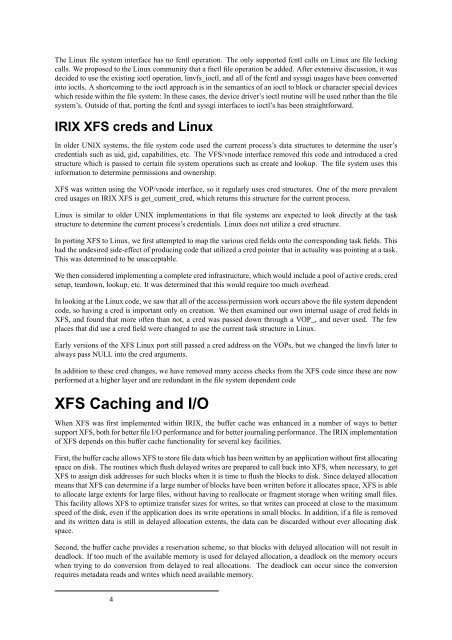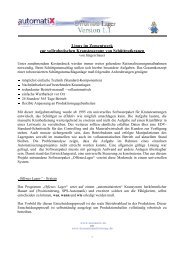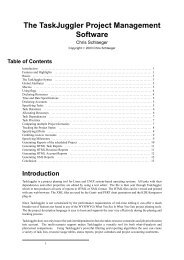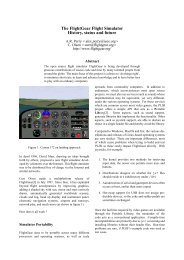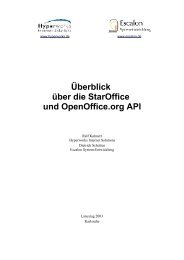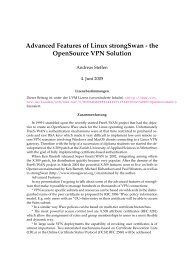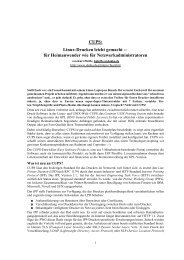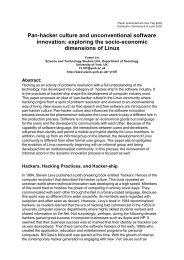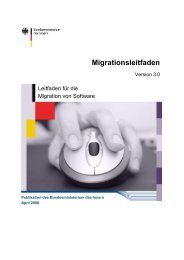You also want an ePaper? Increase the reach of your titles
YUMPU automatically turns print PDFs into web optimized ePapers that Google loves.
The <strong>Linux</strong> file system interface has no fcntl operation. The only supported fcntl calls on <strong>Linux</strong> are file locking<br />
calls. We proposed to the <strong>Linux</strong> community that a fnctl file operation be added. After extensive discussion, it was<br />
decided to use the existing ioctl operation, linvfs_ioctl, and all of the fcntl and syssgi usages have been converted<br />
into ioctls. A shortcoming to the ioctl approach is in the semantics of an ioctl to block or character special devices<br />
which reside within the file system: In these cases, the device driver’s ioctl routine will be used rather than the file<br />
system’s. Outside of that, porting the fcntl and syssgi interfaces to ioctl’s has been straight<strong>for</strong>ward.<br />
IRIX <strong>XFS</strong> creds and <strong>Linux</strong><br />
In older UNIX systems, the file system code used the current process’s data structures to determine the user’s<br />
credentials such as uid, gid, capabilities, etc. The VFS/vnode interface removed this code and introduced a cred<br />
structure which is passed to certain file system operations such as create and lookup. The file system uses this<br />
in<strong>for</strong>mation to determine permissions and ownership.<br />
<strong>XFS</strong> was written using the VOP/vnode interface, so it regularly uses cred structures. One of the more prevalent<br />
cred usages on IRIX <strong>XFS</strong> is get_current_cred, which returns this structure <strong>for</strong> the current process.<br />
<strong>Linux</strong> is similar to older UNIX implementations in that file systems are expected to look directly at the task<br />
structure to determine the current process’s credentials. <strong>Linux</strong> does not utilize a cred structure.<br />
In porting <strong>XFS</strong> to <strong>Linux</strong>, we first attempted to map the various cred fields onto the corresponding task fields. This<br />
had the undesired side-effect of producing code that utilized a cred pointer that in actuality was pointing at a task.<br />
This was determined to be unacceptable.<br />
We then considered implementing a complete cred infrastructure, which would include a pool of active creds, cred<br />
setup, teardown, lookup, etc. It was determined that this would require too much overhead.<br />
In looking at the <strong>Linux</strong> code, we saw that all of the access/permission work occurs above the file system dependent<br />
code, so having a cred is important only on creation. We then examined our own internal usage of cred fields in<br />
<strong>XFS</strong>, and found that more often than not, a cred was passed down through a VOP_, and never used. The few<br />
places that did use a cred field were changed to use the current task structure in <strong>Linux</strong>.<br />
Early versions of the <strong>XFS</strong> <strong>Linux</strong> port still passed a cred address on the VOPs, but we changed the linvfs later to<br />
always pass NULL into the cred arguments.<br />
In addition to these cred changes, we have removed many access checks from the <strong>XFS</strong> code since these are now<br />
per<strong>for</strong>med at a higher layer and are redundant in the file system dependent code<br />
<strong>XFS</strong> Caching and I/O<br />
When <strong>XFS</strong> was first implemented within IRIX, the buffer cache was enhanced in a number of ways to better<br />
support <strong>XFS</strong>, both <strong>for</strong> better file I/O per<strong>for</strong>mance and <strong>for</strong> better journaling per<strong>for</strong>mance. The IRIX implementation<br />
of <strong>XFS</strong> depends on this buffer cache functionality <strong>for</strong> several key facilities.<br />
First, the buffer cache allows <strong>XFS</strong> to store file data which has been written by an application without first allocating<br />
space on disk. The routines which flush delayed writes are prepared to call back into <strong>XFS</strong>, when necessary, to get<br />
<strong>XFS</strong> to assign disk addresses <strong>for</strong> such blocks when it is time to flush the blocks to disk. Since delayed allocation<br />
means that <strong>XFS</strong> can determine if a large number of blocks have been written be<strong>for</strong>e it allocates space, <strong>XFS</strong> is able<br />
to allocate large extents <strong>for</strong> large files, without having to reallocate or fragment storage when writing small files.<br />
This facility allows <strong>XFS</strong> to optimize transfer sizes <strong>for</strong> writes, so that writes can proceed at close to the maximum<br />
speed of the disk, even if the application does its write operations in small blocks. In addition, if a file is removed<br />
and its written data is still in delayed allocation extents, the data can be discarded without ever allocating disk<br />
space.<br />
Second, the buffer cache provides a reservation scheme, so that blocks with delayed allocation will not result in<br />
deadlock. If too much of the available memory is used <strong>for</strong> delayed allocation, a deadlock on the memory occurs<br />
when trying to do conversion from delayed to real allocations. The deadlock can occur since the conversion<br />
requires metadata reads and writes which need available memory.<br />
4


